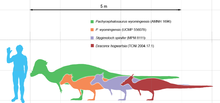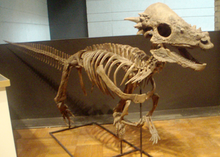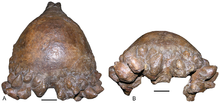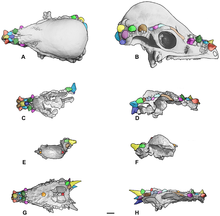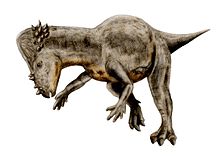
Pachycephalosaurus
Did you know...
SOS Children volunteers helped choose articles and made other curriculum material Visit the SOS Children website at http://www.soschildren.org/
| Pachycephalosaurus Temporal range: Late Cretaceous, 70–65.5Ma |
|
|---|---|
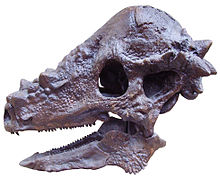 |
|
| Skull cast, Oxford University Museum of Natural History | |
| Scientific classification |
|
| Kingdom: | Animalia |
| Phylum: | Chordata |
| Class: | Reptilia |
| Order: | †Ornithischia |
| Family: | †Pachycephalosauridae |
| Subfamily: | †Pachycephalosaurinae |
| Tribe: | †Pachycephalosaurini |
| Genus: | †Pachycephalosaurus Brown & Schlaikjer, 1943 ( nomen protectum) |
| Species: | † P. wyomingensis |
| Binomial name | |
| Pachycephalosaurus wyomingensis ( Gilmore, 1931 [nomen protectum, originally Troodon]) |
|
| Synonyms | |
|
Tylosteus ornatus Leidy, 1872 |
|
Pachycephalosaurus (pron.: / ˌ p æ k ɨ ˌ s ɛ f əl ə ˈ s ɔr ə s /; meaning "thick headed lizard," from Greek pachys-/παχυς- "thick", kephale/κεφαλη "head" and sauros/σαυρος "lizard") is a genus of pachycephalosaurid dinosaur. It lived during the Late Cretaceous Period ( Maastrichtian stage) of what is now North America. Remains have been excavated in Montana, South Dakota, and Wyoming. It was an herbivorous or omnivorous creature which is only known from a single skull and a few extremely thick skull roofs. This dinosaur is monotypic, meaning the type species, P. wyomingensis, is the only known species. Pachycephalosaurus was one of the last non-avian dinosaurs before the Cretaceous–Paleogene extinction event. Another dinosaur, Tylosteus of western North America, has been synonymized with Pachycephalosaurus.
Like other pachycephalosaurids, Pachycephalosaurus was a bipedal omnivore with an extremely thick skull roof. It possessed long hindlimbs and small forelimbs. Pachycephalosaurus is the largest known pachycephalosaur.
The thick skull domes of Pachycephalosaurus and related genera gave rise to the hypothesis that pachycephalosaurs used their skulls in intraspecific combat. This hypothesis has been disputed in recent years.
Description
The anatomy of Pachycephalosaurus is poorly known, as only skull remains have been described. Pachycephalosaurus is famous for having a large, bony dome atop its skull, up to 25 cm (10 in) thick, which safely cushioned its tiny brain. The dome's rear aspect was edged with bony knobs and short bony spikes projected upwards from the snout. The spikes were probably blunt, not sharp.
The skull was short, and possessed large, rounded eye sockets that faced forward, suggesting that the animal had good vision and was capable of binocular vision. Pachycephalosaurus had a small muzzle which ended in a pointed beak. The teeth were tiny, with leaf-shaped crowns. The head was supported by an "S"- or "U"-shaped neck.
Pachycephalosaurus was probably bipedal and was the largest of the pachycephalosaurid (bone-headed) dinosaurs. It has been estimated that Pachycephalosaurus was around 4.5 metres (15 ft) long and weighed 450 kilograms (990 lb). Based on other pachycephalosaurids, it probably had a fairly short, thick neck, short fore limbs, a bulky body, long hind legs and a heavy tail, which was likely held rigid by ossified tendons.
Classification and systematics
|
|||||||||||||||||||||||||||||||||||||||||||||||||||||||||
| The cladogram presented here follows an analysis by Williamson and Carr, 2002. One genus listed above, Yaverlandia, is no longer considered a pachycephalosaurian. |
Pachycephalosaurus gives its name to the Pachycephalosauria, a clade of herbivorous ornithischian ("bird hipped") dinosaurs which lived during the Late Cretaceous Period in North America and Asia. Despite their bipedal stance, they were likely more closely related to the ceratopsians than the ornithopods.
Pachycephalosaurus is the most famous member of the Pachycephalosauria (though not the best-preserved member). The clade also includes Stenopelix, Wannanosaurus, Goyocephale, Stegoceras, Homalocephale, Tylocephale, Sphaerotholus and Prenocephale. Within the tribe Pachycephalosaurini, Pachycephalosaurus is most closely related to Dracorex and Stygimoloch, although these may be juvenile forms of Pachycephalosaurus.
Discovery and history
Remains attributable to Pachycephalosaurus may have been found as early as the 1850s. As determined by Donald Baird, in 1859 or 1860 Ferdinand Vandiveer Hayden, an early fossil collector in the North American West, collected a bone fragment in the vicinity of the head of the Missouri River, from what is now known to be the Lance Formation in southeastern Montana. This specimen, now ANSP 8568, was described by Joseph Leidy in 1872 as belonging to the dermal armor of a reptile or an armadillo-like animal. Its actual nature was not found until Baird restudied it over a century later and identified it as a squamosal (bone from the back of the skull) of Pachycephalosaurus, including a set of bony knobs corresponding to those found on other specimens of Pachycephalosaurus. Because the name Tylosteus predates Pachycephalosaurus, according to the International Code of Zoological Nomenclature Tylosteus would normally be preferred. In 1985, Baird successfully petitioned to have Pachycephalosaurus used instead of Tylosteus because the latter name had not been used for over fifty years, was based on undiagnostic materials, and had poor geographic and stratigraphic information. This may not be the end of the story; Robert Sullivan suggested in 2006 that ANSP 8568 is more like the corresponding bone of Dracorex than that of Pachycephalosaurus. The issue is of uncertain importance, though, if Dracorex actually represents a juvenile Pachycephalosaurus, as has been recently proposed.
P. wyomingensis, the type and currently only valid species of Pachycephalosaurus, was named by Charles W. Gilmore in 1931. He coined it for the partial skull USNM 12031, from the Lance Formation of Niobrara County, Wyoming. Gilmore assigned his new species to Troodon as T. wyomingensis. At the time, paleontologists thought that Troodon, then known only from teeth, was the same as Stegoceras, which had similar teeth. Accordingly, what are now known as pachycephalosaurids were assigned to the family Troodontidae, a misconception not corrected until 1945, by Charles M. Sternberg.
In 1943, Barnum Brown and Erich Maren Schlaikjer, with newer, more complete material, established the genus Pachycephalosaurus. They named two species: Pachycephalosaurus grangeri, the type species of the genus Pachycephalosaurus, and Pachycephalosaurus reinheimeri. P. grangeri was based on AMNH 1696, a nearly complete skull from the Hell Creek Formation of Ekalaka, Carter County, Montana. P. reinheimeri was based on what is now DMNH 469, a dome and a few associated elements from the Lance Formation of Corson County, South Dakota. They also referred the older species "Troodon" wyomingensis to their new genus. Their two newer species have been considered synonymous with P. wyomingensis since 1983.
Growth
The pachycephalosaurs Dracorex and Stygimoloch may be specimens of Pachycephalosaurus in which the dome and horns are not well-developed, either because the animal was a juvenile or a female. This consideration was supported at the 2007 annual meeting of the Society of Vertebrate Paleontology. Jack Horner of Montana State University presented evidence, from analysis of the skull of the single existing Dracorex specimen, that this dinosaur may well be a juvenile form of Stygimoloch. In addition, he presented data that indicates that both Stygimoloch and Dracorex may be juvenile forms of Pachycephalosaurus. Horner and M.B. Goodwin published their findings in 2009, showing that the spike/node and skull dome bones of all three 'species' exhibit extreme plasticity, and that both Dracorex and Stygimoloch are known only from juvenile specimens while Pachycephalosaurus is known only from adult specimens. These observations, in addition to the fact that all three forms lived in the same time and place, lead them to conclude that Dracorex and Stygimoloch were simply juvenile Pachycephalosaurus, which lost spikes and grew domes as they aged. A 2010 study by Nick Longrich and colleagues also supported the hypothesis that all flat-skulled pachycephalosaurs were juveniles, suggesting that flat-skulled forms like Goyocephale and Homalocephale represent juveniles of dome-skulled adults.
Paleobiology
Nearly all Pachycephalosaurus fossils have been recovered from the Lance Formation and Hell Creek Formation of the western United States. Pachycephalosaurus possibly co-existed alongside additional pachycephalosaur species of the genera Dracorex and Stygimoloch, though these may represent juveniles of Pachycephalosaurus itself. Other dinosaurs that shared its time and place include Thescelosaurus, the hadrosaurid Edmontosaurus, ceratopsid Triceratops, ankylosaurid Ankylosaurus, and the theropods Ornithomimus, Troodon, and Tyrannosaurus.
Scientists once suspected that Pachycephalosaurus and its relatives were the bipedal equivalents of bighorn sheep or musk oxen; that male individuals would ram each other headlong. It was also believed that they would make their head, neck, and body horizontally straight, in order to transmit stress during ramming. However, it is now believed that the pachycephalosaurs could not have used their domes in this way.
Foremost, the skull roof could not have adequately sustained impact associated with such ramming. Also, there is no evidence of scars or other damage on fossilized Pachycephalosaurus skulls. Furthermore, the cervical and anterior dorsal vertebrae show that the neck was carried in an "S"- or "U"-shaped curve, rather than a straight orientation, and thus unfit for direct head-butting. Lastly, the rounded shape of the skull would lessen the contacted surface area during head-butting, resulting in glancing blows.
It is more probable that the Pachycephalosaurus and other pachycephalosaurid genera engaged in flank-butting in intraspecific combat. In this scenario, an individual may have stood roughly parallel or faced a rival directly, using intimidation displays to cow its rival. If intimidation failed, the Pachycephalosaurus would bend its head downward and to the side, striking the rival pachycephalosaur on its flank. This hypothesis is supported by the relatively broad width of most pachycephalosaurs, a trait that would have protected vital organs from harm. The flank-butting theory was first proposed by Sues in 1978, and expanded upon by Ken Carpenter in 1997.
In 2012, a study showed that cranial pathologies in a P. wyomingensis specimen were likely due to agonistic behaviour. It was also proposed that similar damage in other pachycephalosaur specimens previously explained as taphonomic artifacts and bone absorptions may instead have been due to such behaviour.
Diet
Scientists do not yet know what these dinosaurs ate. Having very small, ridged teeth they could not have chewed tough, fibrous plants as effectively as other dinosaurs of the same period. It is assumed that pachycephalosaurs lived on a mixed diet of leaves, seeds, fruit and insects. The sharp, serrated teeth would have been very effective for shredding plants.
